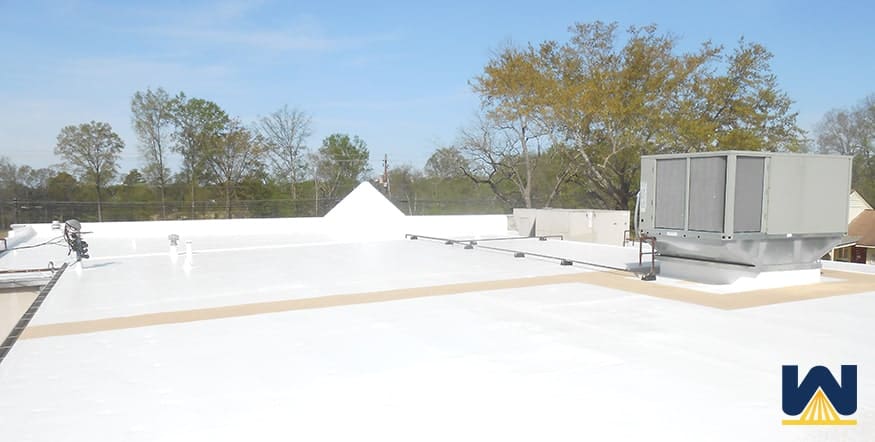There’s a newer phenomenon when it comes to roofing solutions. Can I install an SRM (Silicone Restoration Membrane) instead of doing a complete tear-off?
When you look at the price, one would hope so.
An SRM costs around $3.50-$7 per sq. ft., whereas a complete tear-off costs at least $10 per sq. ft.
But we know there’s more to it than that (or else there would never be another tear-off in the history of roofing).
In this article we’ll cover:
- The costs of each solution and what drives that number
- The warranty differences in an SRM vs a complete tear-off
- The eligibility issues of an SRM
- Reasons building owners choose a complete tear-off over an SRM
- The greatest advantage SRM’s have vs a complete tear-off
Let’s dive in…
Silicone Restoration Membrane vs Complete Tear Off
What are the costs of an SRM vs a complete tear off?
As stated before, an SRM (Silicone Restoration Membrane) costs anywhere between $2 and $4 per square foot. Some factors that influence cost are:
- Size – the larger the project, the better the economies of scale
- Projections – the number of projections can slightly increase costs
- Levels – the different number of levels your roof has can slightly increase the costs
- Repairs – how much of the roof is saturated? The saturated sections will need torn off and replaced with similar material
- Seam Health – how much strength is left in the seams? The better condition your seams are in, the less work that will need to be done.
On a complete tear off, the cost will be at least $10 per square foot. The cost factors in:
- Tear off – the time is takes to tear off the existing roof completely
- Dumpster/Landfill – it costs money to haul away and dump the existing roof in a landfill
- Replace – the costs with your new material, labor, and installation
- R25 – building departments are calling for at least an R-value of 25 on new roofs. This can increase the project’s cost due to the work required (more material, more labor) to get you to an R25.
In previous years, an R20 would be compliant with building codes.
Now that we know SRM’s have an advantage with costs, let’s look at warranties.
What are the warranty differences between an SRM vs a complete tear off?
This one is simple to answer.
An SRM is usually granted a 10- or 15-year warranty. On a new roof (say a spray foam roof), you can get as high as a 20-year warranty.
Can any roof get an SRM? Let’s look at eligibility issues.
What are the eligibility issues of an SRM?
For an existing roof system to be eligible for an SRM installation, the roof needs to be in better condition than most roofs at the end of their serviceable life. Some signs of a roof in good condition include:
- The seams of the existing membrane are relatively intact
- The field of the roof has been properly maintained over its life
- Less than 25% of the underlined substrate and insulation is wet (It is still cost-effective to do spot replacement of small saturated areas rather than a complete replacement.)
Unfortunately, around 20-30% of roofs that we see aren’t eligible for an SRM. It’s usually because building owners never go on the roof or they weren’t enrolled in a maintenance program.
It seems like SRM’s have a clear advantage.
But why would a building owner, who’s eligible for an SRM, still go with a complete tear off?
Reasons building owners choose a complete tear off over an SRM?
The first reason is more R value.
Perhaps the building has high energy costs and would love to install a new roofing solution that’s designed to be more energy efficient.
The second reason is a changing environment inside the building.
Perhaps they need a more controlled environment, or maybe they’re storing a product and that product needs a certain climate.
The third reason is customer preference.
Maybe they weren’t satisfied with the rubber roof they paid for and want to go a different route.
The greatest advantage of a Silicone Restoration Membrane vs a complete tear off
The greatest advantage of an SRM is that’s it’s considered a repair. It’s not considered an additional roof system on top of the pre-existing one.
Building codes say a building can have a maximum of two roofs.
So, if you already have two roofs, and you aren’t eligible for an SRM, you’ll need to perform a complete tear off before adding a new roof.


